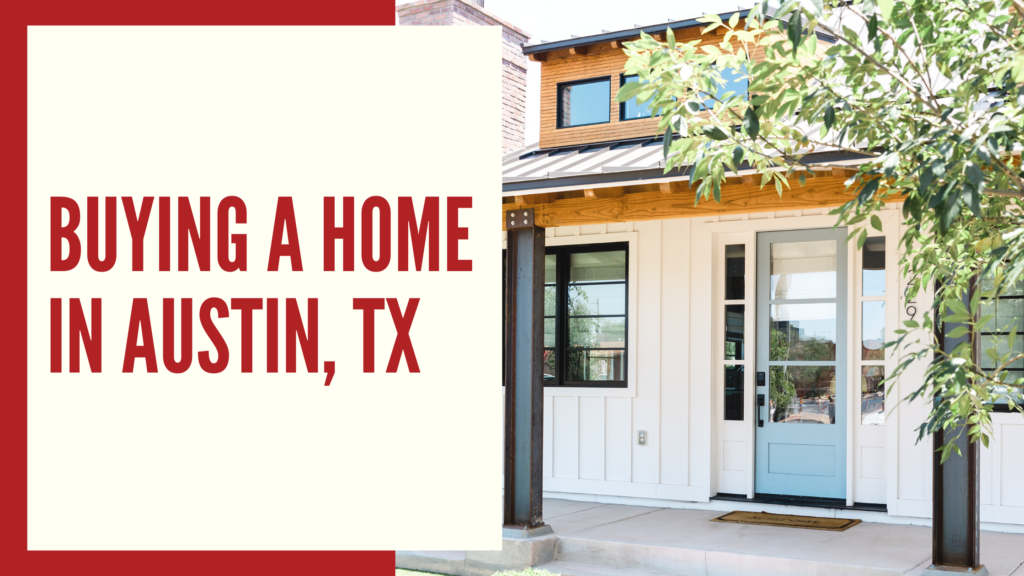
Buying a Home in Austin can feel like navigating through a labyrinth. Navigating Austin’s dynamic and highly sought-after real estate market can be a challenge for both novices and experienced buyers alike. But here’s the thing…
Navigating the intricacies of acquiring a home in Austin doesn’t need to be so intimidating. Yes, you heard that right! If you’re equipped with the right knowledge about neighborhoods, property taxes, mortgage rates – basically all things Austin housing – then this journey might just turn out to be an exciting adventure rather than an intimidating chore.
Why Austin is a Prime Real Estate Market
Austin, Texas has experienced an unprecedented surge in its GDP over the past two decades – a whopping 117%. This economic growth can be largely attributed to the city’s burgeoning tech industry.
Young professionals from around the globe are drawn to this vibrant ‘Silicon Hills’. Major tech corporations like Dell, IBM, and Apple have established significant operations here. These companies create numerous job opportunities that drive housing demand in this dynamic city.
The appeal of Austin extends beyond just employment prospects. The city is renowned for its live music scene and foodie culture. There’s always something happening around town catering to various interests and tastes.
Compared to other large cities such as San Francisco or New York City, Austin’s living expenses are notably lower yet offer similar quality and amenities. Housing costs play a pivotal role here – while home prices have been rising due to increased demand, they remain relatively more affordable than those found in many other major cities.
This affordability isn’t confined only to real estate but also groceries. According to Numbeo, grocery prices are almost 30% less expensive when compared with NYC.
Lifestyle Perks & Cost Efficiency: A Winning Combination
This unique blend of strong career prospects paired with exciting lifestyle perks makes Austin highly attractive not only for young professionals but also for families seeking great schools. Moreover, students find themselves drawn to prestigious institutions like the University of Texas at Austin, making it their destination of choice.
This combination makes investing in buying property within this booming Texan hotspot seem promising based on current trends and forecasts.
Navigating the Austin Housing Market
Within the realm of real estate, Austin is a buzzing hub. The city’s housing market moves at an exhilarating pace, with an average home value of $567,255 in June 2023.
The economic hurdles haven’t slowed down this Texas city; instead, it continues to show remarkable resilience and normalization into early 2023.
To delve deeper into these fascinating trends within the Austin real estate market, resources such as the Austin Board of Realtors provide invaluable insights for potential homeowners or investors looking towards this thriving Texas hotspot.
Understanding Property Taxes in Austin
In Travis County where our beloved ‘ATX’ resides, property taxes are no trivial matter when contemplating your next big move – purchasing a home.
This financial obligation can significantly shape your overall budgeting strategy and long-term monetary commitments that come hand-in-hand with owning property here.
You’d be wise to get well-acquainted with these costs before you make any concrete decisions on buying a house in this central Texas gem.
Decoding Mortgage Rates
Mortgage rates – they’re more than just numbers on paper. They hold significant sway over how much you’ll ultimately shell out over your loan period.
A lower rate means less interest paid atop your principal balance, making understanding mortgage rates crucial during your journey through the bustling world of Austin’s housing market.
If decoding mortgage rates feel like deciphering hieroglyphics, don’t fret. Check out our mortgage calculator below, among other online tools, which could prove handy for those embarking upon their first-time buyer adventure or seasoned pros considering another addition to their portfolio alike.
Finding Your Ideal Neighborhood in Austin
Discovering the perfect neighborhood in Austin, a city renowned for its diverse and vibrant areas, can be an exciting adventure. Whether you’re captivated by downtown Austin’s pulsating music scene or drawn to North Austin’s tranquil suburban life, there are plenty of options that cater to different lifestyle needs.
Considering Commute Times
Your daily commute is not just about getting from point A to B; it significantly influences your quality of life. If your work revolves around popular employment hubs like San Marcos or Central Texas, understanding how long it takes you to travel each day becomes crucial when choosing where within the sprawling metropolis you want to live.

Exploring Lifestyle Amenities
Austin’s unique culture contributes immensely towards enhancing its appeal as a place of residence. The quirky phrase “Austin weird” perfectly encapsulates the thriving arts scene, innovative foodie spots, and numerous outdoor activities offered throughout this dynamic Texan capital.
Downtown offers easy access to cultural landmarks such as the Blanton Museum of Art. In contrast, North Austinites enjoy family-friendly parks, including Walnut Creek Metropolitan Park, among other recreational amenities.
If affordability ranks high on your priority list, then exploring neighborhoods outside these prime areas could yield fruitful results.
With careful research and thoughtful consideration, you will undoubtedly find an area that fits seamlessly with both your budgetary constraints and lifestyle requirements in this fast-growing hub known for its robust real estate market.
Tips for First-Time Homebuyers in Austin
Feeling overwhelmed by the thought of buying your first home? Don’t fret. With the support of our team, your first-time home-buying experience in Austin can be a memorable one.
1. Enlist a Local Real Estate Agent
Navigating the Austin real estate market independently can be daunting; enlisting a local agent with an intimate knowledge of the area could prove invaluable. That’s where local expertise comes into play. A seasoned Austin housing agent, with their finger on the pulse, could prove invaluable.
A proficient agent will understand how various factors like school districts or future development plans impact property values in different neighborhoods such as North Austin or downtown areas. Plus, they’ll have negotiation skills that might just tip purchase prices favorably toward current home values.
2. Financial Preparedness: More Than Just Numbers
Your financial readiness extends beyond being able to afford monthly mortgage payments – it’s about having enough left over each month after meeting all obligations so life remains enjoyable.
- Saving up for Down Payment: Conventional loans usually require a 20% down payment but some lenders may accept less.
- Closing Costs Awareness: These are additional costs incurred when transferring ownership and typically range from 2-5% of the purchase price excluding any loan discount points purchased at closing. Investopedia provides more insights on these expenses here.
Getting pre-approved for a mortgage before starting your house hunt gives you clarity regarding what loan amount lenders might offer based on interest rates along with other aspects including credit score & debt-to-income ratio.
Remember folks – embarking upon homeownership isn’t merely another financial decision…it’s also about shaping your lifestyle choices.
Investing in Rental Properties in Austin
Austin’s real estate sector is flourishing, providing a superb chance to invest in rental housing. This vibrant Texas city attracts students from the University of Texas at Austin and remote workers seeking more affordable living options.
The constant influx of new residents makes owning rental property not just viable but potentially highly profitable. It’s all about understanding how to leverage this growth effectively.
Understanding Rental Yield
Rental yield – ever heard of it? If you’re interested in real estate investment, then knowing the concept of rental yield is essential. In simple terms, rental yield represents the annual rent income as a percentage of the purchase price.
To calculate it accurately: take your yearly rental income divided by what you paid for that beautiful downtown Austin home or North Austin apartment complex; multiply by 100 – voila. You’ve got yourself an idea of profitability based on current figures.
Evaluating Potential Rental Income
Your potential earnings largely hinge upon location within high-demand areas like Central Travis County or near university campuses. The better located your property is (think proximity to amenities), the higher occupancy rates can be expected which directly impacts achievable rents.
Websites like Zillow, Trulia, and Rentometer among other platforms provide detailed insights into comparable rentals nearby- consider factors such as size & number of bedrooms/bathrooms along with any unique features while comparing prices.
Remember though- expenses related to maintenance costs are part-and-parcel when evaluating overall returns.
Future Outlook of The Austin Real Estate Market
The future is looking bright for the Austin real estate market, with numerous indicators pointing toward sustained growth. As a thriving tech hub and culturally rich city that draws in young professionals, families, students, and remote workers alike – housing demand in this Texas hotspot shows no signs of slowing down.
Taking into account current trends and forecasts from reputable sources like U.S Census Bureau’s Population Estimates Program, it’s clear to see why so many are keen on investing here.
Growth Drivers Impacting Home Prices
The population expansion in Austin is having a major influence on the rising cost of homes. More people moving into this vibrant Texas city due to its flourishing job market and high-quality lifestyle amenities means increased housing demand which naturally boosts property values over time.
This trend isn’t expected to slow anytime soon either – Travis County (home to most of Austin) has been one of America’s fastest-growing counties for several years now according to census data. This ongoing surge bodes well for prospective homeowners or investors eyeing properties within the bustling metropolis.
Rental Property Prospects
If you’re considering investment opportunities within downtown or North Austin areas where rental yield tends to be higher thanks to largely proximity university campuses such University of Texas along many top employers areas, prospects look equally promising. A steady influx of students and remote workers coupled with limited supply of rentals should keep occupancy rates healthy thus ensuring stable income investors.
Downtown: With its lively nightlife scene filled with music venues and trendy eateries alongside an array of corporate offices startups alike making prime location renters seeking work-play balance their lives.
North Austin: Known as ‘Silicon Hills’, offers great potential return investments given the large presence of tech companies IBM, Apple, and Dell among others attracting scores of employees need nearby accommodation.
- Near university campuses: Areas around UT-Austin and other colleges tend to have consistent student populations requiring off-campus living options providing reliable source tenants and landlords year-round.
- Del Valle: Dell Valle, 7 miles from Austin, boasts Austin-Bergstrom Airport, Circuit of the Americas, Austin360 Amphitheater, and Tesla’s Gigafactory. The Gigafactory generated jobs and fueled Del Valle’s growth, benefiting from its proximity to Austin.
Austin’s real estate market is a goldmine for prospective homeowners and investors, thanks to its tech-driven growth, vibrant lifestyle, and high rental yields. With no signs of slowing down, it’s time to stake your claim in this Texas hotspot.
FAQs in Relation to Buying a Home in austin
Is it smart to buy a house in Austin right now?
Yes, despite the competitive market, Austin’s strong economy and population growth make it a solid investment for homebuyers.
Is it worth buying a house in Austin?
Absolutely. With its thriving tech scene, vibrant lifestyle, and steady real estate appreciation rates, owning property in Austin can be beneficial long-term.
What salary do you need to buy a house in Austin?
According to an article by Axios, in March 2021, a minimum income of $69,116 was necessary to purchase the median home available for sale in the extended Austin metropolitan area. Presently, an income of $97,210 is required for the same purpose.
Are home prices dropping in Austin TX?
No, while there are seasonal fluctuations and slight slowdowns due to economic conditions, overall trends show consistent growth of home prices in Austin.

Conclusion
So, you’ve journeyed through the ins and outs of Buying a Home in Austin. You now understand why this vibrant city is such a hot real estate market.
You’ve gained insight into the cost of living in Austin, from average costs for houses to taxes and mortgage rates. Navigating neighborhoods doesn’t seem so daunting anymore, right?
The future outlook seems promising too for both homeowners and investors alike in this Texas hotspot. Your adventure into Austin’s real estate world has just begun – armed with knowledge, ready to conquer!





